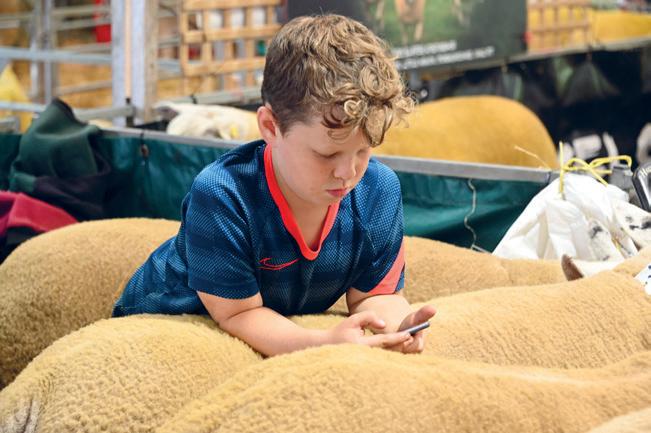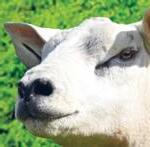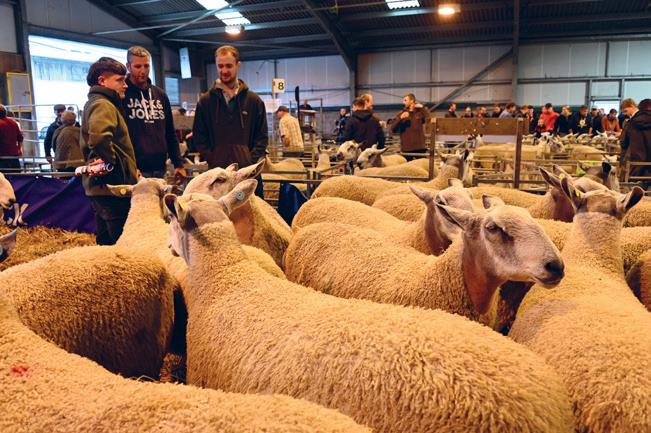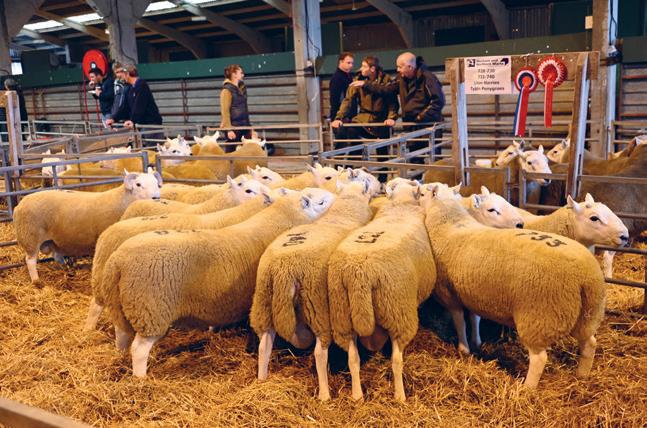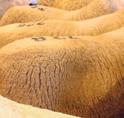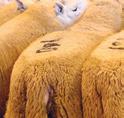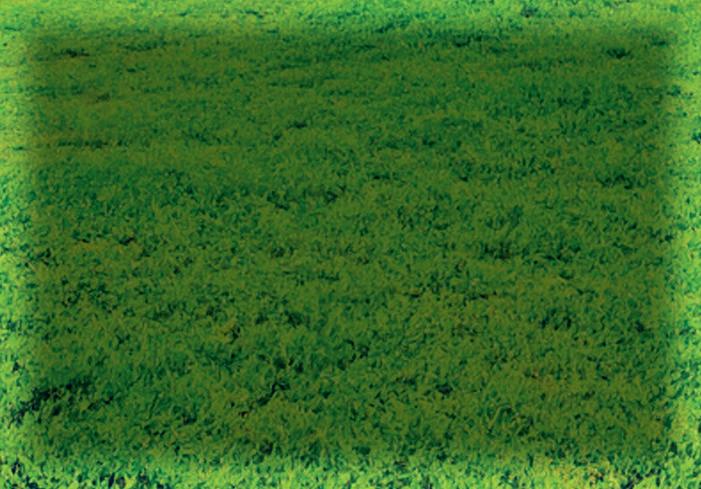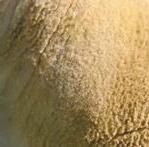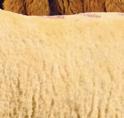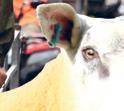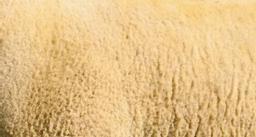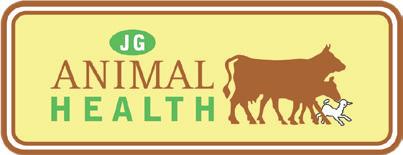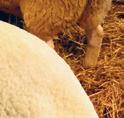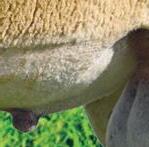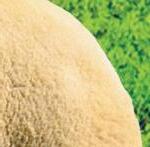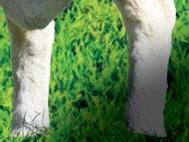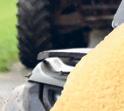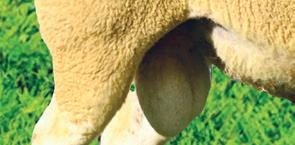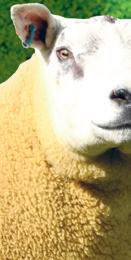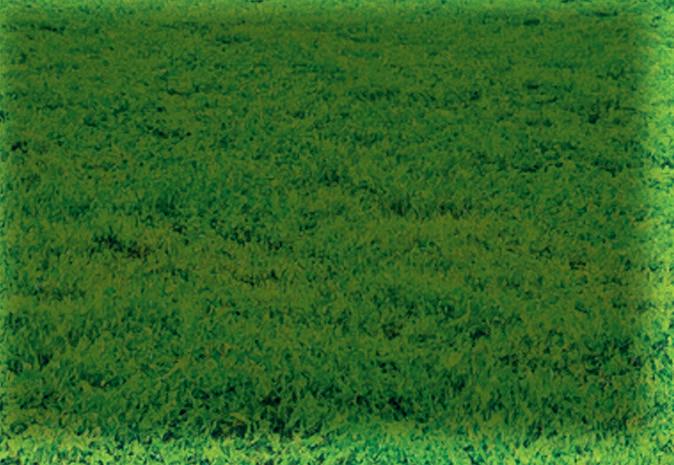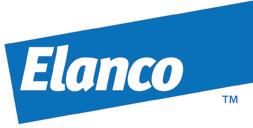










FLY AND MIDGE RISK
With bloodlines dating back to the 1950s, the Dalesbred breed is at the heart of the Dawson family’s farming heritage. Katie Fallon finds out more.












With bloodlines dating back to the 1950s, the Dalesbred breed is at the heart of the Dawson family’s farming heritage. Katie Fallon finds out more.
Situated in the Lancashire valley of Littledale, looking over to Morecambe Bay, is Field Head Farm, home to John and Linda Dawson and their children, Katie, eight, and Emma, 10.
Farmed together with John’s parents, Michael and Carolyn, the farm spans from 229 metres (750 feet) to more than 549m (1,800ft) above sea level, comprising 162 hectares (400 acres) of tenanted grassland and inbye land, a 36ha (90-acre) allotment owned by the family, along with grazing rights on Littledale Common.
Before taking on the tenancy at Field Head Farm in 1983, Michael farmed with his father next door.
It was in these early days that the foundations of the family’s Dalesbred flock were laid, with Michael’s father first starting with the breed in 1952. John was added to the tenancy at Field Head Farm in 2014, after working part-time on local farms and at home.
“After my granddad and uncle retired, I ended up with the best 20 ewes and 10 gimmer hoggs, which started my own flock of Dalesbreds,” says John.
Within John and Michael’s flocks, marked separately, but run as one, the bloodlines from John’s grandfather’s flock remain today, with records to prove it.
John says: “We can go right back to Granddad’s flock; every sheep is recorded and their offspring.
“We still do it today with everything recorded in lambing time.”
Emma and Katie also have their own flock of Dalesbred ewes, which started with an in-lamb shearling that Linda’s mum bought for the girls from Bentham auction market in 2016, after it was champion in the pre-sale show.
This makes Emma and Katie the






The Dawson family first started with Dalesbreds in 1952.
fourth generation of the Dawson family to keep the Dalesbred breed.
Linda says the girls now have five Dalesbred ewes and have taken over their great-grandfather’s flock number.
She says: “They have had two tup shearlings out of them and had a day off school to go and sell them at the auction. The headmaster authorised it and he came to watch the sale.”
Today the family runs a combined flock of 150 pure Dalesbred ewes, 600 Swaledale ewes and 10 Bluefaced Leicester ewes.



While the majority of the Dalesbred flock is bred pure, 50 ewes are put to the Bluefaced Leicester tup each year to produce Dales Mules.
A similar system is run with the Swaledale ewes, with 250 ewes tupped by the Bluefaced Leicester each year to produce North of England Mules and the remainder bred pure.
The family will sell around 40 Dales Mule gimmers and 190 North of England Mule gimmers each year through Bentham auction market in September.
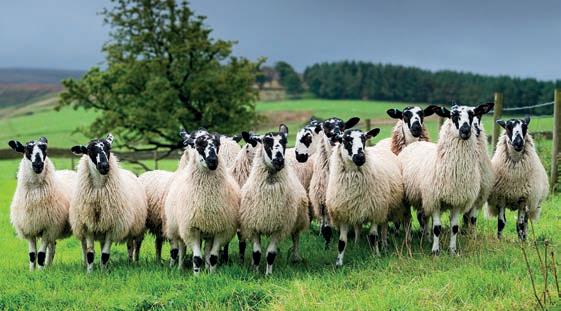
A total of 50 Dalesbred ewes are put to the Bluefaced Leicester tup to produce Dales Mules.
John believes the following for the Dalesbred is growing, with a ‘buzz’ around the breed.
He says: “The Dales Mules are also getting a lot more popular. They make a good, thick-set sheep that is easy fleshing.
The family also sells 30 pure Dalesbred ewes annually at the Dalesbred Sheep Breeders Association draft ewe sale at Bentham, as well as 120 threecrop Swaledale ewes.
John says: “We will sell two or three of the best Dalesbred ewes at the society’s in-lamb ewe sale at Bentham.
“We try to sell two or three every year to support and promote the breed.”
Michael adds: “There are quite a few young people looking to start Dalesbred flocks.”
Wether lambs are grazed off farm for a couple of months, before being sold through Bentham or Lancaster auction market.
John says: “We sell them straight off



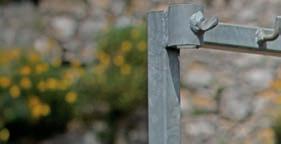




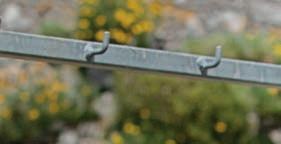

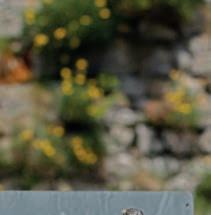












































■ 162 hectares (400 acres) of tenanted grassland and in-bye land and grazing rights on Littledale Common
■ 36ha (90-acre) allotment owned by the family
■ Flock comprises 150 pure Dalesbred ewes and 600 Swaledale ewes
■ John and Michael are committee members for the Dalesbred Sheep Breeders Association
■ The farm is run between John, Linda and Michael, with help from Alan Taylor who works part-time and David Kelsal at lambing time
■ Herd of 35 Limousin cross and pedigree Limousin suckler cows
grass with any horned wether lambs going liveweight.
“We try to get rid of most of them before the start of February, but will sell some as stores.”
A selection of home-bred and boughtin tups are used, with 10 Bluefaced Leicester tups, five Dalesbred tups and nine Swaledale tups currently in the flock. Everything is lambed outside.
The ewes bred to the Bluefaced Leicester start lambing at the end of March, with the pure Dalesbred and Swaledale ewes lambing in the first week in April.
“After lambing, the ewes with singles, mainly those with gimmer lambs will go up to the common so they can get hefted to their area of the fell,” says John.
All gimmer hoggs then go up onto the common at the start of April once they return from winter grazing.
Preventative health is a priority at Field Head Farm and the family works closely with the local vet practice to ensure they are proactive with flock health.
The flock is vaccinated annually against clostridial diseases, orf, footrot, campylobacter, and

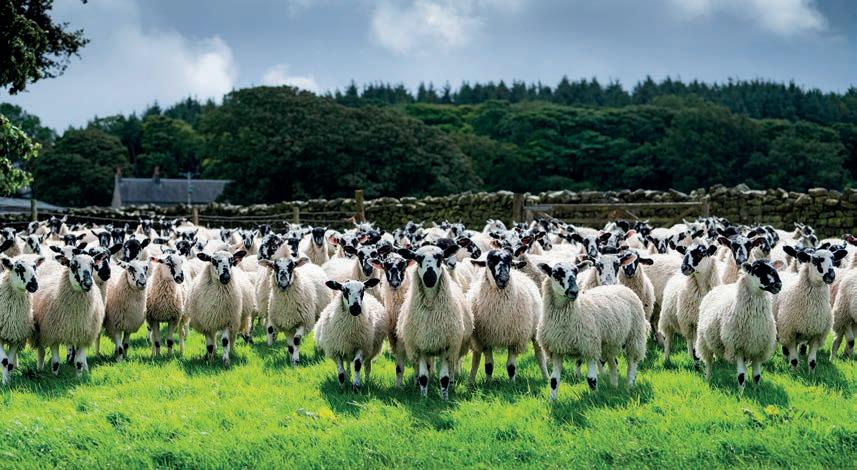
A total of 250 Swaledale ewes are crossed with the Bluefaced Leicester each year to produce North of England Mules.
toxoplasmosis and enzootic abortion.
Alongside the sheep enterprise, the family runs a herd of 35 Limousin cross and pedigree Limousin suckler cows.
Calving takes place between January and April, with calves sold between six to eight months old at the suckler sale at Bentham in October.
As well as selling breeding females, the family also sells a handful of Dalesbred tups each year, and in 2004 Michael broke the breed record price with a shearling ram which sold for 8,000gns.
That record was upheld until 2017, when the Taylor brothers, Tosside, sold a tup for 10,000gns, which John and Michael bought in partnership with Frank Brennand, Chapel-le-Dale.
The record now stands at 12,000gns for a tup bred by Mick Car, says John.
Other tups that have performed well in the flock include one bought from the Bainbridge family, Marrick, and more recently a Wallbank-bred tup.
John says: “We have been lucky with the flock, probably because of the
back breeding, but we have done well, and the tups have clicked.”
The family has also seen success in the showring, exhibiting at Westmorland County Show and Hornby Show most years.
Michael says: “We have won the Dalesbred championship two years on the trot at Westmorland.”
Both Michael and John have also won the championship at the Dalesbred tup show and sale at Bentham, with Michael winning it five times and John three times since 2003.
The Dawson family has rarely veered away from Dalesbreds since starting with the breed in the 1950s.
Michael says: “I had a spell with Bleu du Maines, crossing them with the Dalesbred and Swaledales. They were good lambs with good shape and conformation, but did not really catch on.”
And with the breed well suited to the height and extremity of Littledale, the family has chosen to stick with the breed.
“They can cope with the wind and
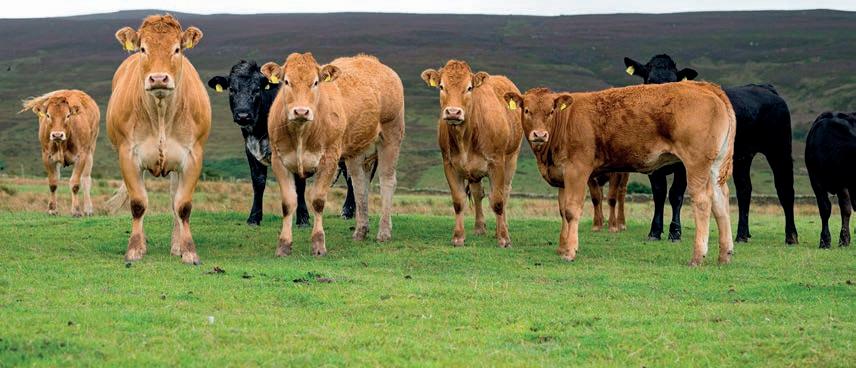

They can cope with the wind and rain and are easy fleshing and easy to keep; they also have a good mothering ability
MICHAEL DAWSON
rain and are easy fleshing and easy to keep; they also have a good mothering ability and milk well,” says John. Michael adds: “They thrive as well at 700ft as they do at 1,800ft. They have a bit more shoulder than other breeds so have a good conformation and fatten well.”
John and Michael say they are always aiming to improve and produce a better example of the breed each year.
“We try to stick with the type we have always had: good conformation and quality, with a good black-andwhite face, hard hair and a white nose,” says John.
Michael adds: “That good white then comes out in the Dales Mules.
“Our Wallbank tup has a good white nose which comes out in his offspring, and he has done tremendously well for us.”
With no plans for expansion, John says producing quality breeding stock and the best example of the breed will remain a priority, alongside encouraging the fourth generation of Dalesbred breeders, Katie and Emma, to follow in the family’s footsteps and succeed with the breed.


- Pre-tupping to improve conception rates
- Pre-lambing to improve lamb vigour
- Early lambs for quick weight gain















“Split flock trials showed a 10-15%





“The results obtained with ProVitaMin were nothing short of remarkable. Of the two ewes flushed that year, one produced 25 embryos which the other produced 19. Subsequent to this 23 of the embryos produced were implanted into commercial recipients leading to 18 lambs scanned. Also used on all the flock, fertility has dramatically improved.”









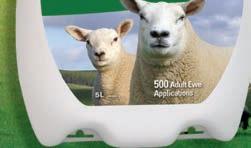




“ProVitaMin drench is used pre-tupping and on all lambs before weaning to boost weight gain and overall condition for show and sales. It is a versatile drench and with the small volume application a bottle goes a long way.”


“The first round of ProVitaMin drench helps boost ewe fertility levels while the second acts to increase lamb vitality. I also ensure that the ewes selected for AI receive the mineral and vitamin boost. All the lambs get ProVitaMin prior to weaning. This ensures that growth rates are not reduced, once they are taken off their mothers.”


“The flock was split into two groups - the ewes drenched with ProVitaMin tupped several days before those tupped with the competitor product. The ProVitaMin drench was much easier to use as it was a smaller amount given.”


“Using ProVitaMin has boosted ewe and lamb performance in terms of fertility and growth rate. This has resulted in an extra ½ lamb per ewe sold for us this year.”






Breeding top-quality Scotch Mules has been the cornerstone of the Thornborrow family’s sheep enterprise since the beginning and continues to be an important part of the business.
Run by father and son duo Malcom and Gary Thornborrow, together with Gary’s fiance Marian Porter, the family’s sheep enterprise is based at Easter Dawyck near Peebles in the Scottish Borders. Malcom’s older son Craig shepherds at Nunnerie Farm, Biggar, but is also involved in the enterprise and helps out where he can.
A Dawyck Estate farm, owned by
the Balfour family, Malcom took on the tenancy at Easter Dawyck 16 years ago after working and contract shepherding on local hill farms.
Easter Dawyck comprises 101 hectares (250 acres) of mainly in-bye land with some hill ground, and the family runs a mixed flock of 700 ewes, including 400 Lanark type Scottish Blackface ewes, 200 Scotch Mule ewes and 50 pedigree crossing Bluefaced Leicester ewes. Additional summer grazing is taken annually.
As well as Easter Dawyck, the family has recently taken on part of the neighbouring estate farm, Dawyck Mill, and they also manage 500 Scotch


Mule and 200 Scottish Blackface ewes for Dawyck Estates.
Gary also runs a contract farming business which spans several thousand hectares throughout the Tweed Valley, overseeing 2,800 Scottish Blackface ewes across 3,440ha (8,500 acres) on several local hill farms.
One of the main farms which Gary contract shepherds is Fruid Farm, which the family has been involved with for over 50 years.
Gary says: “Dad and Granddad shepherded there, then I was a self-employed shepherd there for 10 years and have now contract farmed there for 15 years.”
Scottish Blackface ewes
The Fruid hills span 2,246ha (5,500 acres) from 335 metres (1,100 feet) above sea level to 808m (2,650ft). Here, Gary runs a flock of 1,800 Scottish Blackface ewes and a small flock of 40 South Country Cheviot ewes with help from Gordon Maclntyre, who works full-time at Fruid Farm.
All ewes are bred pure, with 1,500 male lambs sold deadweight straight off their mothers each year.
Gary says: “They are all sold entire, with only one worm dose administered. We aim for 35-36kg and feel this is the best way to market them currently.”
The majority of ewe lambs are kept as replacements, with any surplus sold for breeding. Approximately 20 Scottish Blackface tups are retained for breeding, with between eight and 10 tups bought in each year.
Between the farms on Dawyck
[Scotch] Mule ewe lambs is extremely important MARIAN PORTER
Estate and the contract farming enterprises, lambing starts at the beginning of March with the Bluefaced Leicester ewes lambed inside, followed by the family’s own Blackface and Scotch Mule flocks in late March and the estate’s flock, which lambs outside, in early April.
Marian says: “We aim to have these finished lambing before the hill ewes start in April, then we will lamb about 900 pairs of Blackface twins from Fruid and the other hill farms at Easter Dawyck.”
The rest of the Blackface ewes that are scanned for singles will lamb outside on the hill or in hill parks, with lambing usually coming to an end in early June, just in time for the Royal Highland Show.
Teaser tups are used on all the in-bye ewes to create a tighter lambing period.
Gary says: “We have done this for four to five years now and it works








It can also be used proactively to support calves and lambs that are potentially at risk of stress or infection e.g.
• if slow to suckle
• weaning or feed change
• from handling and transportation
• when in contact with other scouring animals.


What farmers tell us:
“We have used Rehydion successfully for many years. It is easy to administer as it can be diluted in milk, which means there is no interruption to milk feeding.”









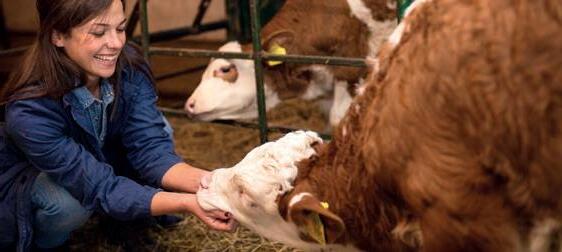
















About 300 Scotch Mule ewe lambs are sold annually, with the top pen of 50 sold at St Boswells.

Rehydion is an oral rehydration therapy gel that provides su cient essential electrolytes to correct acidosis and still allows continued milk feeding (when given at the recommended levels), as it does not disturb milk clot formation or delay abomasal emptying1




REFERENCE: 1. Constable 2009. Comparative e ects of two oral rehydration solutions on milk clotting, abomasal luminal pH and abomasal emptying rate in suckling calves. J. Dairy Sci 92:296-312.
For further information visit ruminants.ceva.co.uk
well as long as you get your timing right with the ewes.”
At Easter Dawyck, all 400 of the family’s Scottish Blackface ewes are tupped with the crossing Bluefaced Leicester to produce Scotch Mules.
Gary says: “The Blackies are mainly bred with home-bred tup lambs to try them out before selling them as tup shearlings.”
About 300 Scotch Mule ewe lambs are sold annually, with the top pen of 50 ewe lambs sold at St Boswells in September, and the next 60 lambs sold at United Auctions in Stirling.
The remainder are sold privately on farm, with any surplus kept as replacements.
Marian says: “Breeding the Scotch Mules is the bit we enjoy the most out of all the breeds, and producing quality Mule ewe lambs is extremely important.”
This passion has undoubtedly been reflected in the sale ring, with the family holding the breed record price for a pen of 51 Scotch Mule ewe lambs at St Boswells, which sold for £295 per life in 2022 to Jimmy and Graeme Sinclair, Heriot.
Malcom says: “With a Scotch Mule you always want your conformation and good skin to start with, then that extra something special comes with a clean, sharp look.”
He says having a Mule with good colours, flashy white hair and clean legs is key to producing the best example of the breed.
The family has also reaped rewards in the showring, claiming reserve inter-breed champion at Biggar Show this year with a Scotch Mule gimmer lamb, and champion Scotch Mule and champion pen of three Scotch Mules at Peebles Show just a few weeks ago.
The Scotch Mule is an essential part of the family’s sheep enterprise, and alongside selling ewe lambs, 200 Scotch Mule ewes are crossed with a Suffolk tup each year, with the ewe lambs sold privately for breeding.
Gary says: “All wether lambs are fattened off grass by the end of November and sold to Woodhead Brothers, Turriff, averaging 21.4kg deadweight.”
All Scotch Mule gimmer shearlings are crossed with the Texel tup each year, with ewe lambs sold privately and all wethers sold off grass to Woodhead Brothers.
“We have tried a few other cross breeds but found there was too much variation in the prime lambs so went back to the Suffolk and the Texel,” says Gary.
The same system applies to the
estate ewes, which they also manage.
A crucial part of the Scotch Mules’ success is the family’s crossing Bluefaced Leicester flock. Originally started by Malcom, Craig was gifted the full Nunnerie flock by Alistair MacArthur, which provided a great foundation to build on.
The flock has continued to grow over the years and is a passion of Craig, Gary and Marian’s.
The family aims to sell about 30 crossing Bluefaced Leicester tup lambs each year and 30 tup shearlings, as well as 50 breeding females, including ewe lambs and gimmer shearlings.
Gary says: “We have sold females to a high of 6,000gns twice through Harrison and Hetherington’s online sale, and 5,500gns at Carlisle’s female sale in January.”
About 12 ewes are flushed annually, with a large selection of embryos and semen also sold throughout the year.
Tups are sold through Hawes, Carlisle, Stirling, Kirkby Stephen, Bentham, North West Auctions, and Kelso tup sale. Gary says they achieved their best price to date last year, with a tup lamb sold through Hawes for 28,000gns.
He adds: “The year before was probably our best year, when we sold tups for 17,000gns, 16,000gns, two tups at 10,000gns, one at 7,500gns



and one at 8,000gns. Numerous sale champions and top prices that year were all bred by tups we sold the previous year.”
Both Marian and Gary say they are trying to breed ‘top-end’ crossing Bluefaced Leicester tups which appeal to the majority of Leicester breeders. Bloodlines which have helped them along the way include the 30,000gns M1 Hewgill and the record-breaking 65,000gns P1 Riddings.
Malcom says: “There are three main points we try and keep when breeding our tups: good conformation, good Mules and desirable. We feel we need to have all three to be successful. We try to keep the Leicesters and Scotch Mules as our main focus, to breed them to the best of our ability.”
Again, this passion for producing the best example of the breed has seen the family achieve one of their biggest highlights to date, winning the crossing Bluefaced Leicester championship at the Royal Highland Show in 2017, and overall inter-breed sheep pairs. They have also been placed reserve Leicester champion at the Royal Marian Porter and Gary Thornborrow say they are aiming to breed ‘top-end’ crossing Bluefaced Leicester tups.




Highland Show for the last two years.
A high health status is maintained at Easter Dawyck, with a proportion of the flock maedi visna (MV) accredited. A scrapie monitoring scheme is also operated, and vaccination for footrot has been introduced this year to try and eliminate any foot health issues.
The Bluefaced Leicester flock is vaccinated for enzootic and toxoplasma abortion, with all other ewes also vaccinated for enzootic abortions and clostridial diseases.
“We scratch lambs for orf and have scanned all sheep for ovine pulmonary adenocarcinoma for the last 10 years, following a trial with Moredun Research Institute,” says Gary.
High-quality
With the aim to breed only the best, the family remains dedicated to producing the highest quality of each breed across their various flocks. Looking to the future, a focus on breeding high-quality Scotch Mules and Bluefaced Leicester progeny will continue to be a priority.
And with Gary and Marian’s pending nuptials, the couple are also aspiring to purchase their own farm, hopefully in the not-too-distant future.
■ Lambing percentages for the flocks include 206% for Scotch Mule ewes, 172% for in-bye Scottish Blackface ewes and 120% for hill Scottish Blackface ewes
■ The family also runs a herd of 20 Limousin cross suckler cows
■ Calves sold as stores at 12 months old through St Boswells auction market
■ 14 hectares (35 acres) of pasture is reseeded each year into a longterm grazing ley or silage mix
■ All silage is baled in-house together with the neighbouring estate farms





an essential part of the sheep enterprise at





l Helps enhance fertility in ewes and rams.
l Supports overall vitality and readiness for the tupping season.
l Helps improve conception rates and lambing percentages.
l Aids tighter lambing.





“I used the pre tupping drench before tupping and before lambing on all of my ewes. The lambs were excellent quality and the ewes’ milk was rocket fuel.


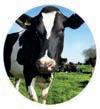
Aids in the healing of Digital Dermatitis and Footrot in cattle and Granuloma (strawberry foot), foot abscess, Whiteline & Shelly Hoof, Footrot (Dichelobacter Nodosus) & CODD (Contagious Ovine Digital Dermatitis in sheep.
Farms with a 2% abortion rate should investigate enzootic abortion in ewes this lambing season, said David Longbottom, of Moredun.

Ahead of tupping season, sheep farmers are being reminded of the economic and welfare risks that abortion poses to the flock. Ellie Layton finds out more.
Acontains
bortion in sheep is estimated to cost UK sheep farmers up to £128 per ewe and is responsible for 30% of lambing losses and stillbirths.
&
Reseal tub after use Do not discharge into drains or the environment
Seek medical advise if needed
At a webinar held by the National Sheep Association, the Animal Plant and Health Agency and Moredun warned farmers not to overlook abortion, despite the symptoms not always being clear.
There have been issues with the availability of vaccines this year
If swallowed, rise mouth with water
which might present challenges in some flocks, and farmers were advised to speak to their vets if they
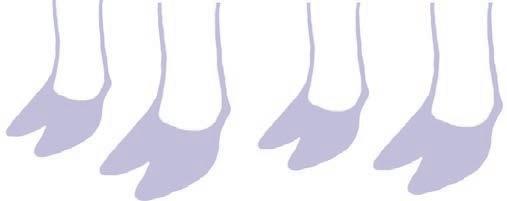
then bandage, leave for 2-3 days, remove, clean & repeat for a further 2-3 days, remove again and only re-apply if necessary. Wear gloves If contact with skin, wash off immediately with soap & water, If contact with eyes, wash out immediately with water for 15 minutes
had major concerns about abortion.
David Longbottom, of Moredun, said farms with a 2% abortion rate should investigate enzootic abortion in ewes (EAE) this lambing season.
Also known as chlamydial abortion, enzootic abortion is caused by infection with the bacteria chlamydophila abortus. The bacteria damage the placenta, reduce the transfer of nutrients to the growing lamb and inhibit the production of the hormones that regulate pregnancy, with the potential to damage the lamb directly.
the time of lambing can result in naive animals contacting infected or aborted materials. In unvaccinated flocks, the infection can quickly spread through the flock, leading to abortion storms and large-scale losses.”
For these reasons, he said it was essential for aborted materials such as dead lambs and placental material to be removed, pens disinfected thoroughly between ewes and bedding changed.




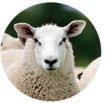

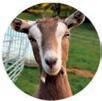

Beware of Inferior Imitations!
Aids in the healing of Digital Dermatitis & Slurry Heel in cattle. Granuloma (strawberry foot) foot abscess, Whiteline & Shelly Hoof Footrot (Dichelobacter Nodosus) & CODD (Contagious Ovine Digital Dermatitis) in sheep.
Actively seeking
CZF & CZ hoof products do
contain
With it being a later developing disease, Mr Longbottom said the first signs of EAE in a flock would usually be late-term abortions, stillbirths, or births of weak, illthrift lambs.
Abortions usually occur in the last three weeks of gestation. Aborting ewes often display a redbrown discharge that might only be seen in the fleece around the perineum, with typically no accompanying symptoms.
Mr Longbottom said: “EAE is a contagious disease that is amplified when flocks are housed for lambing. The proximity of animals at
£128


Estimated cost of abortion per ewe.
30%

Percentage of lambing losses and stillbirths which are due to abortion.
“Enzootic abortion is a zoonotic disease, meaning it can pass from animals to humans. The main at-risk groups are pregnant women and immune-compromised people, who should not encounter ewes during lambing time,” he said.
To confirm a diagnosis, fresh samples of the aborted placenta can be tested. But the major issue with the disease is that animals exposed to infectious materials at lambing might not show signs of infection until the subsequent lambing.
Mr Longbottom said: “Ewes that have EAE and have aborted or lambed within the past three months will produce an immune response to the infection. Therefore, blood samples should be taken from aborted or barren ewes up to three months after lambing, costing about £10 per ewe. However, bought-in sheep can only be tested if they have lambed in the previous three months.”
After a ewe is infected, it will not typically abort or show other signs
A vaccination policy is a cheap insurance policy compared with the potential [lamb] losses
of EAE until the following pregnancy, and once it has aborted it is less likely to abort in subsequent years.
However, Mr Longbottom recommended that aborting ewes should ideally be culled from the flock, as they could act as carriers of the disease and pass it on to other animals.
The timing of vaccination depends on the product used. All vaccines are required to be given before breeding, so farmers should
ensure they act promptly and do not leave it too late.
Mr Longbottom added: “Farmers should discuss vaccination options with their vets, implementing it in their flock health plan. Weigh up the cost of lamb losses against the cost of vaccination; a vaccination policy is a cheap insurance policy compared with the potential losses.
“Because of cost considerations, some farmers will just implement the vaccination in incoming or replacement ewes.
“This is not a robust vaccination protocol, but it will ensure the most naive animals are protected and over time the flock should become fully covered, depending on the replacement rate.”
Also speaking from Moredun, Lee Innes focused on toxoplasmosis, which, unlike EAE, is exclusively an environmental disease challenge.
She said: “Unlike EAE, toxoplasmosis cannot spread from sheep to sheep, but its availability to ewes around the farm means that a ewe

can easily pick up the disease, and normal biosecurity measures are not enough to control it.”
Toxoplasmosis is caused by the toxoplasma gondii parasite.
“It has been estimated that up to 90% of sheep flocks in the UK come into contact with the disease. It is most commonly spread by cats, which host the parasite and shed parasite eggs, known as oocysts, into the environment via faeces.
“Seen in earlier stages of pregnancy than EAE, infection of a ewe can be reflected in foetal absorption, stillbirth, a mummified foetus or the birth of a weak lamb,” added Ms Innes.
With there being no practical medications available that could cure sheep infected with toxoplasma or prevent the disease, Ms Innes insisted on the importance of vaccinating young breeding ewes.
Vaccination costs stand at about £5 per dose, with the application protecting ewes for at least two lambing seasons. Due to the nature of the disease, it would only be required for the youngest members of the flock each year, therefore spreading the cost.
Ms Innes said this was equivalent to less than 1% of the value of a single lamb.
Ewes must be vaccinated at least three weeks before going to the ram, and Ms Innes advised to view the disease as a certain risk as it was so widely seen in UK flocks.
She added: “Infection during pregnancy can see serious consequences, so it is well worth making sure all breeding ewes are vaccinated before they go to the ram for the first time.”
For those selling breeding stock, the vaccination status sees a premium at autumn sheep sales, and if farmers are buying breeding replacements close to tupping time they might not have to vaccinate incoming ewes against infectious abortion causes.
This is a big plus at a time when there is a high density of other health treatments to consider, or when it might be too late to schedule the vaccination for any young bought-in ewes that have not been vaccinated previously, putting the current flock at risk.






Ideal to use in:
• Finishing Lambs: Hit target weights quicker
• Replacement Ewe Lambs: Start your sales preparation with the right trace element supplementation
• Long Keep Store Lambs: Avoid falling into the increased trace element gap over the winter months

Are you buying in replacement ewe lambs? Have they had their bolus?
4 months trace element supplementation for £0.05 per week*



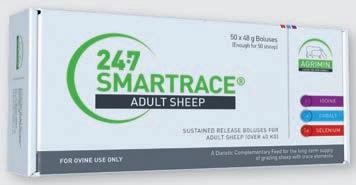

Ideal to use at:





• PRE-TUPPING: Optimise conception rates and lambing percentages
• SCANNING: Support lamb vitality and optimise colostrum quality


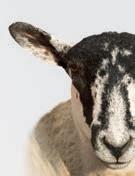
6 months trace element supplementation for £0.06 per week*
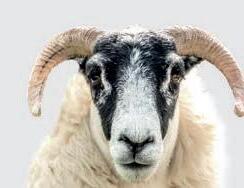



A young farmer is breathing a new lease of life into the family farm following a change of breed to North Country Cheviots. Ellie Layton reports.
For the last 24 years, Brynowen in Trefeglwys, near Newtown, has been run by Christine Lewis. She was first offered the hill land by her father on a farm business tenancy as she had already built a house on the land back in 1987, which is now their family home.
Together with her husband Bernie, who is a plumber by day, and their two children – India and Ffloyd – whose keen interest in farming has seen several changes to the farm business to secure a firm future in the industry.
From the tenancy, the system has been built up on the hill ground, and has seen building added to establish their current farm.
She had already built a house on the land in 1987, which was used as a holiday cottage to generate income.
Her passion for sheep saw her set up a flock of Lleyn sheep, which
We were very impressed with their mothering abilities, milkiness and lambing percentage [...] We knew they were the right choice
FFLOYD LEWIS
were kept until recently, when the mother and son team decided to shift the sheep system to North Country Cheviots, following an investment to set up a small pedigree flock, which Ffloyd says was ‘just for fun’.
He says: “My mother established
the Lleyns over 20 years ago and had developed a very successful flock. Moving away from years of bloodlines was not an easy decision, but is one we hope will benefit the business in uncertain times within the industry.”
But it is a choice that Christine was keen to make to ensure her son was given the same opportunities as a young farmer that she was at the start of her farming career.
The home farm and part of their locally rented ground is mainly hill and upland ground, but they also rent land in Caersws, which is lower lying, and in 2018 they saw the installation of a 32,000-bird free-range hen unit to allow Ffloyd to return home after studying agriculture at Newtown College.
Caersws is where their flock of North Country Cheviots started in 2019 with a handful of Park types.
Christine says: “The original Lleyn flock was an obvious choice for me, as they were growing in popularity. They are good mothers and very prolific, so

we were able to build up the flock in a fairly short period of time, which peaked at 350 MV-accredited ewes.”
The family had a great deal of breeding success with the Lleyn breed, in show and sale rings, having champion ram at the breed’s official sale in Carlisle on two occasions and claiming the breed champion title at the Royal Welsh Show five times.
But peaking at 1,200ft, Brynowen is an open farm which is fairly late growing and wet, so they found that through the spring they were feeding more concentrates than they desired.
Something Ffloyd found most restricting with the flock was complying with MV rules, meaning their flock needed to be MV-accredited, so they were limited when grazing part of the farm which neighbours non-MV farms.
During this time, Ffloyd’s fondness for the Cheviot breed had grown for his Park flock.
He says: “We had always loved the look of the North Country Cheviot with their bold stance, sharp head and character. So we went up to Lockerbie and bought ewes from the Carruthers and Hownam Grange flocks which ran with a Humbleheugh ram, with a view of keeping a small flock for showing and breeding elite females, which has now grown to 50 ewes.”
The deciding factor that this was the right breed has been their ability to halve the amount of concentrates they had been using.
With this in mind, they made the choice to buy some Hill type Cheviots to utilise their hill land and bought 100 six-year-old ewes in Lockerbie from the Woodside, Hethpool and Buchtrig flocks alongside a ram from the Benger flock.
They chose well-rounded, midsized ewes, with good feet and mouths, as well as tight skins, and
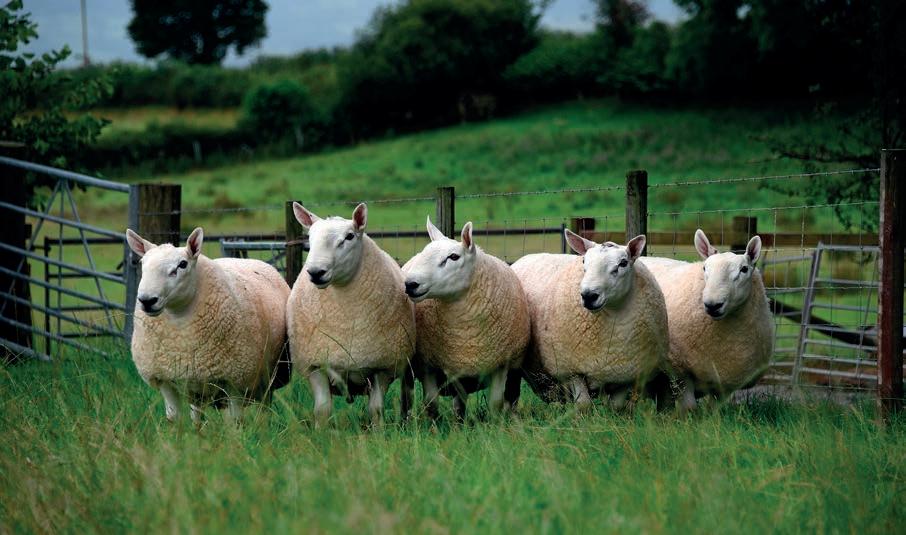
tried to buy from the best flocks where possible.
They chose to buy their sheep from the North, which is their preferred type and has given them more choice.
Ffloyd says: “We were very impressed with their mothering abilities, milkiness and lambing percentage of 160%. We knew they were the right choice in changing our breed, without completely changing our system, and we made the decision to retain all of the ewe lambs.
“This summer saw the last of the Lleyn ewes leave Brynowen before we will head up north to Lockerbie in autumn to regain flock numbers.”
They plan to continue lambing inside, but have hopes of transitioning to an outside lambing flock after not assisting one Cheviot lambing this year.
The Park ewes lamb towards the end of March, while the Hill ewes lamb at the start of April.
Some of the farm’s Cheviot Park rams.
■ Mother and son team, Christine and Ffloyd Lewis, run Brynowen
■ The last few years have seen them transition from a Lleyn to a North Country Cheviot flock
■ Both Hill and Park type ewes are kept in the flock
■ Laying hens and Aberdeen-Angus cows are also part of the system
The Cheviot breed has breathed a fresh enthusiasm into the farm, allowing the family various options for the flock.
Ffloyd says: “We are currently breeding the Cheviots pure to help build up flock numbers, most recently with three rams bought locally from the Bennett family’s Plasucha flock, which have done well.

“We want to keep a closed flock in future to keep the high health the Lleyns gave us, but we also have the versatility of cross-breeding if we want to.”
Their early breeding has had quick success for them in the showring too, as they decided to make their Brynowen flock debut at the Royal Welsh Show last year.
They were pleasantly surprised to claim reserve female champion with their home-bred Park aged ewe on their first time out.
They returned this year with home-bred stock to take a second prize with a yearling ram and aged ewe as well as a fifth with another aged ewe.
Traditionally, they have sold 95% of stock liveweight, which they also would like to continue. Last year, they kept the ram lambs entire and they were sold through their local market, Welshpool, and averaged 40-45kg and made £125/head in autumn off grass, which helped to cement that this was the right move for the business.
antly surprised with the breed. They are weighty lambs from birth, despite lambing easily from their mid-sized ewes.”
Ffloyd says: “We have been pleas-
The aged ewes are showing longevity, but have also delivered a higher cull price than the Lewis family has previously seen.


Along with the sheep, changes have also been made by introducing cattle to the system.
Last year saw 10 pedigree Aberdeen-Angus cows brought to Brynowen, and their first crop of calves are on the ground.
The family plans to sell the offspring as stores in Welshpool next year and looks forward to them helping to improve the grassland, which Ffloyd is slowly reseeding for the first time in 45 years.

The implementation of a five-point sheep lameness plan can improve flock health and welfare. Farmers Guardian reports.
Acollaborative sheep lameness disease management project, which is driven by GB lamb procurer Pilgrim’s UK with support from MSD Animal Health, has enabled farmer participants to reduce flock disease incidence by two-thirds and slash antibiotic usage for treating foot bacterial infections by 64%.
Eleven sheep units holding more than 13,000 ewes were involved in the two-year project, with a cohort of flocks in South West England and another in Wales. The objective was to reduce lameness prevalence on each of the farms to the 2% target set by the Farm Animal Welfare Committee, as well as reduce antimicrobial usage associated with the disease.
Pilgrim’s UK lamb supply chain manager Liz Rees says: “Our producers always focus on achieving high welfare and productivity standards, as well as driving environmental sustainability.
“Managing lameness is such a challenge for so many flocks and can be soul-destroying for farmers, but this project has shown all involved that you do not have to accept a high disease incidence simply because you have sheep.”
At the start of the project in 2020, the combined lameness prevalence figure across all 11 farms was 5.5%. By the end of the project, average lameness prevalence had been reduced to 1.8%.
The lameness prevalence improvement came from rigorous implementation of the FAI Farms five-point sheep lameness reduction protocol on all the farms.
Project co-ordinator Sonja van Dijk, of MSD Animal Health, says: “The five-point plan gives a clear strategy for managing any foot problems. Implemented correctly over the longer term, it builds natural disease resilience within a flock, reduces the disease challenge and spread on farm, and improves flock immunity through vaccination.
“It involves treating affected animals promptly, culling persistent offenders, avoiding the propagation of infection when sheep are gathered, quarantining any bought-in stock, and routine whole-flock vaccination against footrot.”
At the start of the project, each of the 11 participating farms undertook a lameness control assessment by a trained adviser using the MSD Animal Health lameness control

The five-point plan provides a ‘clear strategy’ for managing foot problems, says Sonja van Dijk of MSD Animal Health.
planner. This assessment was then repeated every six months to monitor progress and ascertain the need for six- or 12-monthly vaccination boosters.
of the project, the total cost of lameness to the 11 farms involved in the project was significant.


By the end of the sheep lameness and disease management project, average lameness prevalence had been reduced to 1.8%.

GETTY
“Rigorous implementation of all areas of the five-point plan undoubtedly led to the significant lameness prevalence improvement on all the farms. As a result of the actions taken, the lameness control assessment scores improved dramatically from a combined 14.5 out of 25 at the start of the project to 22.1 out of 25 after two years,” says Ms van Dijk.
In addition to the welfare benefits, all producers saw a reduction in antibiotic usage, with PCU values decreasing from 7 to 2.5 over the twoyear project. This equates to a 64% reduction in antimicrobial usage for the treatment of lame sheep.
Ms van Dijk estimates that in 2020, immediately before the start
She says: “Based on industry estimates, in lost productivity and medicine usage alone the 11 units were looking at a collective cost of £187,800 per year.
“And that does not include the time involved in catching and treating lame sheep. But by 2022, after two years’ work, the estimated cost of disease had been reduced to £53,680 per year, representing a substantial saving of £134,200.”
Ms van Dijk also calculates a significant cost benefit from using a footrot vaccine.
“Based on the experience with this core group of more than 13,000 ewes, vaccination against footrot over a five-year period would only cost £2.58 per ewe per year, yet save £11.42 per ewe per year. That is more than a four times return on investment each year,” she says.
A DRAMATIC reduction in antibiotic use for lame sheep and a significant decrease in the time he and his two sons spend treating affected animals are the main benefits that Powys sheep and suckler producer Robert Jenkins says he has gained from the lameness reduction project.
Managing 2,100 breeding ewes plus 600 replacement ewe lambs on his 526 upland hectares (1,300 acres) near Caersws, he is delighted with the results.
“Having to constantly turn lame sheep over really gets farmers down. I always say that if you let the sheep get on top of you, then you will be really stressed,” he says.
Targeting a lambing percentage of 180%, Mr Jenkins is progressively moving away from Welsh ewes towards a more productive Aberfield cross Romney flock, which lambs between March 20 and May 15. Historically, footrot has been






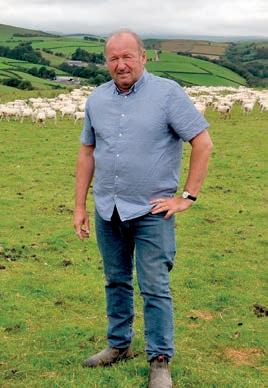
the main infectious lameness disease issue on farm, and although whole flock vaccination was implemented previously, Mr Jenkins had stopped using the vaccine in recent years. Unfortunately, footrot problems slowly started to creep back.

We now vaccinate all ewe lambs with their primary course and boost the older ewes annually in December or January
ROBERT JENKINS
“We always seemed to be treating sheep with antibiotics –too much so, in fact – so when the opportunity to participate in this project came along, I jumped at the chance to get involved to gain a better understanding of lameness disease management,” he says. Running what is now a closed
flock and rigorously implementing the five-point plan has made a massive difference to foot health.
“Alongside a strict culling policy, and rapid and appropriate treatment of any sheep we do see lame, we now vaccinate all ewe lambs with their primary course and boost the older ewes annually in December or January.
“The only sheep we buy in are new tups, and these get vaccinated too,” says Mr Jenkins.
“We are also heavy lime users in our sheds, as well as outside in the field. This limits the spread of any foot infection from sheep to sheep.
“And we are meticulous with our biosecurity protocols.
“Having sheep farming contractors coming onto the farm is always a risk, so we now shear our own sheep. And when the scanner visits, we make sure the sheep handling equipment has been fully disinfected.”


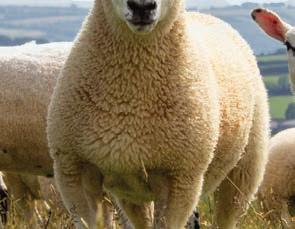

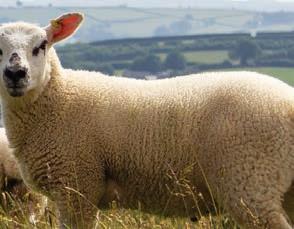

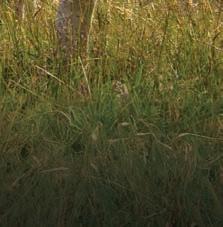






















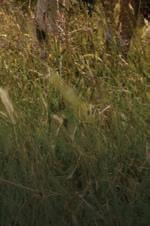






Whether or not to tup hoggs can be a tricky decision, especially when the focus is on growing your flock. SAC sheep specialist Poppy Frater offers some advice.
Richard McCornick farms Barnbackle, a 200-hectare (500-acre) beef and sheep farm, which he runs alongside his partner, Hayley Currie, and his parents, Andrew and Janice.
The farm, which is a Quality Meat Scotland Monitor Farm, runs 700 Texel cross Mules, 150 Sim-Luing sucklers and 20 stores.
Ewes winter on kale and swedes, and lamb indoors, with lambs sold off grass. With a focus on growing the flock to 900 ewes, productivity is key.
So, while there may be an initial reluctance to tup hoggs, often, when they have had a good summer and have grown and are looking well, Mr McCornick will put them to the tup. However, while this
Richard McCornick runs 700 Texel cross Mules at Barnbackle.


appears to work well, the hoggs often have a high scanning rate, which can be an issue.
Poppy Frater, SAC sheep spe-
cialist, says: “This can put too much stress on the hoggs when they are still growing and seems to increase mastitis issues over the long term.”
So while tupping hoggs can boost productivity, it also increases culling rates, which can mean the flock makes no, or very little, progress towards expansion.
Ms Frater says: “There are two options for hoggs. The first is not to put them to the tup at all, leaving them to grow and tup them the following autumn.
“The second is to tup them this year, but with a breed which will give a lower scan and smaller lambs.
“This means there will be much less need to intervene at lambing, reducing stress, and they can be out at grass for lambing. Using something like a Shetland tup would be a good option.
“Tupping the hoggs now is a bit like ‘training’ them for lambing and



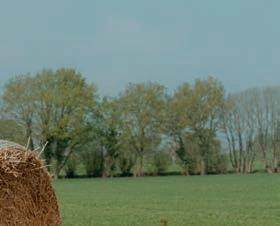








■ Ensure ewe hoggs are 60% or more of mature ewe weight
■ Aim for small single lambs
■ Opt for smaller breed of tup Hogg tupping tips
means you will have a ewe lamb which is well grown and more experienced for the following pregnancy.”
Making sure hoggs meet target weights before tupping is critical.
Ms Frater says: “Ewe lambs should be at least 60% of mature ewe weight, and gimmers 85%.
“This is really influential on their performance, including scanning rate. Not many people will weigh, but weigh if you can.
“This group can often be forgotten, but where, say, 20% of your flock are young ewes, making sure they are target weight or more can be really influential to your lambing percentage.
“Even if you have decided against tupping them as hoggs, it is important to focus on getting as many of them as possible to that 60% target this autumn.
“Weight affects the onset of pu-


Ensuring ewe hoggs are at least 60% of mature ewe weight before tupping is critical, says Poppy Frater.
berty, and you want female sheep to be as fertile as possible. They are your future breeding flock and it is crucial to look after them.”
Ms Frater says: “Tupping after the main flock would work best and also gives them longer to grow before tupping.
“It also means that they are lambing outside in potentially better weather, are not putting any strain on already over-stretched
housing at lambing and are almost always better mothers as a result.
“First-time lambers are very sensitive and there is less disturbance when they lamb outside. This means there is less mismothering and the hoggs lamb naturally themselves.”
Where farms decide to lamb hoggs inside, space is essential, particularly for younger ewes. If there is a lack of space, they will hold onto
their lambs for longer and so produce more dopey lambs. It will also affect ewe-lamb bonding.
“Think about increasing shed space now or putting up polytunnels like they are planning to do at Barnbackle,” she says.
For more on Monitor Farm Scotland’s farms, meeting reports and technical information, go to monitorfarms.co.uk
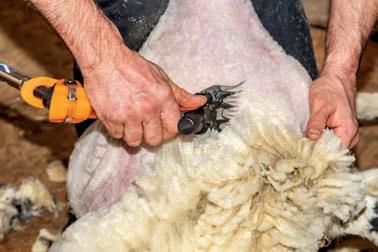
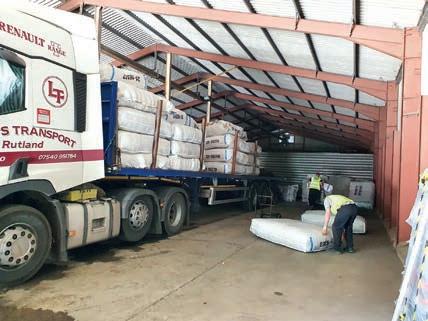


To find your nearest depot or drop off site visit britishwool.org.uk/depot-network





A Welsh sheep farmer says it is important to choose quality products with proven efficacy when it comes to parasite prevention. Farmers Guardian finds out more.
Daniel Pritchard is the third generation farming at Weobley Castle Farm, Llanrhidian, near Swansea.
Alongside his father, Roland, he runs 1,000 EasyCare and Welsh Mule ewes across 101 hectares (250 acres) of coastal lowland.
The Pritchards’ Gower Salt Marsh flock is the largest to graze the salt marshes in the UK.
With growing popularity in recent years, most of the produce is sold online directly to consumers, with any lambs remaining after Christmas sold via an abattoir or the local market.
Mr Pritchard explains his sheep graze on the tidal marsh, with these pastures providing the flock’s main source of forage in the summer months.
He says: “The sheep spend most of their time on the salt marshes, but they come in for lambing, shearing and other treatments, as well as during high tide.
“Apart from that, they are out on the marshes and, while there are a few different flocks down there, they know which parts are home for them.
“Our unique type of grazing gives the lamb a much sweeter and slightly stronger flavour because of their unique diet.”
He explains the forage on the salt marshes is rich and diverse, consisting of salt marsh grass, sea lavender and samphire.
“This provides the flock with plenty

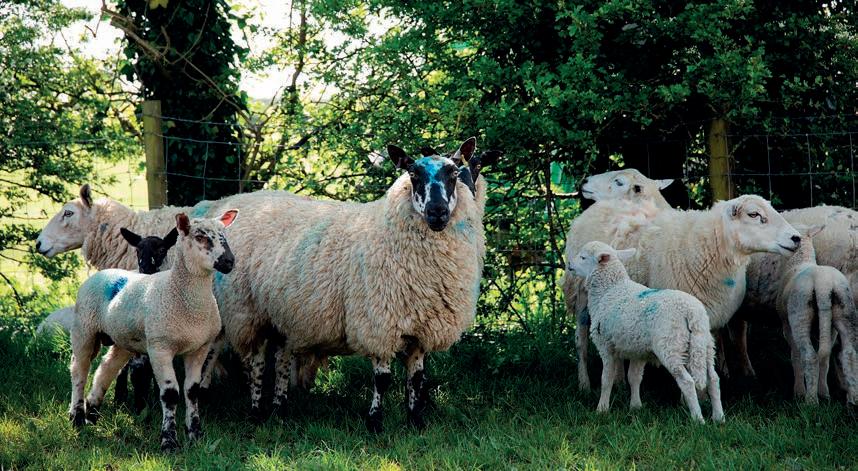
of key nutrients that contribute to good growth rates. We benefit from being able to run a fairly low-input system, because we do not touch the salt marshes with any artificial inputs.”
With the added complexity of grazing logistics, Mr Pritchard’s focus on animal health ensures he is producing top-quality, high-welfare animals.
One way in which he protects flock health is to focus on limiting worm resistance. He explains that incorporating a Group 4 wormer has become an integral part of his routine to tackle this.
“We have got confirmed resistance

to Group 1 and 2 wormers, so we administer a late-season break dose of Group 4 Zolvix to remove any worms that have been left behind from previous treatments.”
In addition to this, he uses the Group 4 wormer as a quarantine dose for when replacements arrive on the farm, to prevent any resistant worms being brought in, even though he uses trusted suppliers.
The marsh’s salty conditions create an environment less favourable for parasites, including blowflies. Nonetheless, Mr Pritchard explains strike prevention remains a key part of his health and welfare strategy.
“It can be hard to know exactly when fly populations arise and how long strike risk will last, as the weather conditions vary year on year. But it is important lambs are protected for the season,” he says.
To assess the risk of blowfly strike, he uses Elanco’s Blowfly Watch Service which provides localised alerts as and when strike risk changes.
Mr Pritchard says: “I look at the Blowfly Risk Forecast to see when the fly pressures are rising, combined with the local weather conditions. Then I can take a preventative ap-
proach rather than a corrective one.” He has had the most success preventing strike cases by administering an insect growth regulator that offers up to 19 weeks of protection.
“We apply this at the start of the season, before sheep are turned out in May. This gives us peace of mind that we are covered for the whole summer as we do not really see the flock while they are away on the marsh.
“As a result, we have seen very little fly strike, and when we do, it is only because we have missed a sheep.”
To ensure the fly protection works as effectively as possible, Mr Pritchard points out he uses the four-stroke application method.
This method ensures a consistent four-inch band of product is applied to the fleece for maximum protection.
He adds: “Preventing fly strike has always been important to our business; I do not want to consider the financial and welfare implications of not managing it correctly in the first place.”
Mr Pritchard’s method certainly is not without reason, as research has shown that mortalities caused by blowfly strike can cost farmers in the UK up to £209 per lamb and £184 per breeding ewe.





















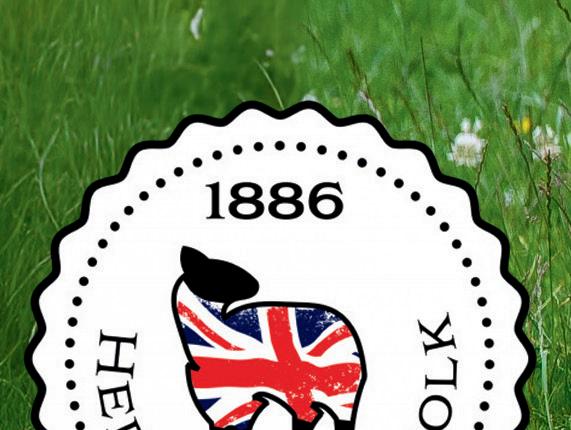





WELSHPOOL (01938) 553438
Wednesday 11th September (Ewes)
Thursday 12th September (Ewe Lambs)
Thursday 10th October (Ewes & Ewe Lambs)
HEREFORD (01982) 553228
Friday 13th September (Ewes & Ewe Lambs)
Tuesday 15th October (Ewes & Ewe Lambs) RUTHIN
(01824) 702025 & (01745) 583260
Saturday 14th September (Ewes & Ewe Lambs)











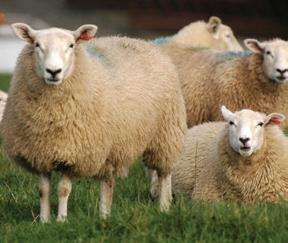








August
Bentham Friday 30th August
Bentham Saturday 31st August
September
Barnard Castle Tuesday 3rd September
Longtown Wednesday 4th September
Leyburn Friday 6th September
Cockermouth Friday 6th September
Wigton Saturday 7th September
Penrith Tuesday 10th September
Carlisle Thursday 12th September
Longtown Tuesday 17th September
Skipton Tuesday 17th September
Hexham Wednesday 18th September
Kendal (NWA J36) Saturday 21st September
Kirkby Stephen Saturday 21st September
Bentham Friday 27th September
Leyburn Friday 27th September
October
Skipton Tuesday 1st October
Bentham Saturday 19th October
nemsa@btinternet.com www.nemsa.co.uk 0789 699 2598



September
*Hexham Thursday 5th September
Skipton Tuesday 10th September
Kirkby Stephen Friday 13th September
Kendal (NWA J36) Saturday 14th September
Bentham Saturday 14th September
Hawes Monday 16th September
Hawes Tuesday 17th September
Longtown Tuesday 17th September
Middleton-in-Teesdale Wednesday 18th September
Lancaster Wednesday 18th September
Wigton Wednesday 18th September
Pateley Bridge Wednesday 18th September
Barnard Castle Thursday 19th September
Carlisle Thursday 19th September
*Hexham Thursday 19th September
Cockermouth Friday 20th September
Leyburn Friday 20th September
Penrith Tuesday 24th September
Skipton Tuesday 24th September
Lazonby Alston Moor Wednesday 25th September
Tow Law (at Hexham) Thursday 26th September
St John’s Chapel Friday 27th September
Bentham Saturday 28th September
* Denotes the Marts will be selling Mules out of both Northumberland type Blackface and Swaledale dams.
October and November dates are available on the website : www.nemsa.co.uk






Friday 6th & Saturday
of PEDIGREE BELTEX SHEEP 7th September Sale of PEDIGREE BLUE TEXEL & BADGER FACE TEXEL SHEEP
Tuesday 10th September Sale of 6,000 NORTH OF ENGLAND MULE GIMMER LAMBS
Tuesday 17th September 2nd Sale of SHEARLING GIMMERS & Sale of all classes of BREEDING SHEEP + CHAROLLAIS RAMS
Thursday 19th & Friday 43rd Annual Sale of 20th September 600 PEDIGREE TEXEL RAMS & FEMALES
Tuesday 24th September 2nd Sale of 8,000 MULE GIMMER LAMBS
Tuesday 1st October
Sale of all classes of BREEDING SHEEP Inc PENNINES SALE of CHEVIOT, LONK, GRITSTONE, WHITE FACED WOODLAND EWES & SHEARLINGS Evening sale of BLUE FACED LEICESTER SHEEP
Thursday 3rd October Sale of REGISTERED LLEYN BREEDING SHEEP
Friday 4th October 1200 TERMINAL & NON TERMINAL SIRES MVA & Non MVA TEXEL, SUFFOLK, BELTEX, CHAROLLAIS, BLUE TEXEL, ZWARTBLES, DUTCH TEXEL + TERMINAL SIRES & CROSS BRED
Saturday 5th October Sale of 3,500 SWALEDALE EWES & SHEARLINGS For catalogues and more information please call 01756 792375 or visit our website www.ccmauctions.com









SHOW & SALE OF BALWEN WELSH MOUNTAIN SHEEP Saturday 21st September 2024 Show at 10am - Sale at 1pm Entries close - 23 August

The Only Livestock Market in Staffordshire Autumn 2024 Store & Breeding Sheep Sales Over 65,000 Head
Sale of Store Lambs, Ewe Lambs and Breeding Sheep Alternate Saturdays Throughout The Season *
17th August - Early Sale of Breeding Sheep (MV & Non-MV Sections) 7th September - Including Prize Show & Sale of Shearlings 21st September – Including Prize Show & Sale of Breeding Ewe Lambs 5th& 19th October 2nd, 16th & 30th November 14th December * Sales of Breeding Rams MV & Non-MV Sections
Saturday 28th September Saturday 26th October *
Two Special Breed Sales Include; Wednesday 21st August - 6pm
Beltex Society Evening Show & Sale To Include Beltex Males & Females & Friday 13th September - 6pm Derbyshire Texel Club Show & Sale ‘Derbyshire Dazzlers’ To Include Texel Males & Females *
All Sheep Sold Through a Sale Ring With Buyers Attending From a Wide Area Catalogued Entries Only - Entry Forms Now Available Enquiries: 01538 372749 Email: leek@auctionmarts.com

Southdown Sheep Society official sales provide the best opportunity to purchase veterinary inspected, high quality sheep from leading Southdown flocks. Both MV and non-MV accredited stock available at this official Society Sale, giving buyers an unrivalled selection of quality stock.














Livestock Centre Croesbychan, Bryngwyn, Usk, NP15 2BH 01873 852624 www.balwensheepsociety.com
13th & 14th September (pre-sale show on September 13th) The Traditional Native Breeds Sale www.meltonmowbraymarket.co.uk sales@meltonmowbraymarket.co.uk
Catalogues available online www.meltonmowbraymarket.co.uk Telephone: 01986 782251 www.southdownsheepsociety.co.uk email: secretary@southdownsheepsociety.co.uk
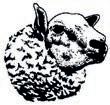
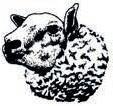

SATURDAY 14TH SEPTEMBER AT 10AM
SHOW & SALE OF BREEDING SHEEP & STORE LAMBS
Show & Sale of Shearlings, Ewes & Gimmer Lambs & Store Lambs Show at 9am, Sale at 10am
Entries Close 2nd September at 12 noon
TUESDAY 17TH SEPTEMBER AT 4.30PM
EVENING SHOW & SALE OF RAMS Show to commence at 3pm, Sale at 4.30pm Schedule available.
Entries close 3rd September at 12 noon
SATURDAY 12TH OCTOBER AT 10AM
SALE OF BREEDING SHEEP & STORE LAMBS
The breed helping to tackle climate change; Climate change is adapted and mitigated by lowering co2, less methane.
THE BRAMAIN FLOCK IS THE LARGEST FLOCK, 300+ EWES IS SIGNET RECORDED AND IS CONSISTENTLY USING NEW BLOOD LINES DIRECT FROM FRANCE
Has a good selection of sheep for sale at Welshpool 26th September
Also always available on farm Shearling Ewes, Ewe Lambs, Ram Lambs & In Lamb Breeding Ewes For more information please contact: David Eglin, Bramcote Mains, Bulkington CV12 9JX Web link to sale brochure: bramcotemain.wordpress.com/2022/8/ email: bramcotemains@outlook.com
Sale of Shearlings, Ewes, Rams, Gimmer Lambs & Store Lambs Entries Close 30th September at 12 noon
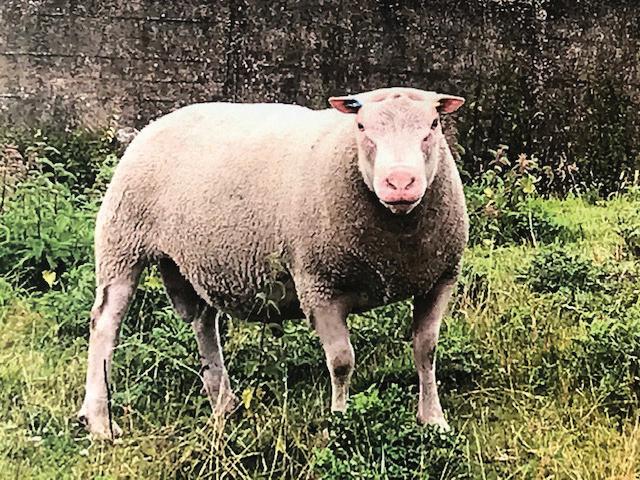






SENNYBRIDGE MARKET, POWYS 01874 622 488
Every Saturday – 2000 + Store Lambs and 1000 + Cull/Grazing Ewes. All Store Lambs Sorted and Weighed. 20kg to 40kg available.

GIMMER LAMBS - Wednesday 18th September 10.30am
Thursday 19th September - Annual On Farm Sale of 800 Draft Cheviot Ewes and 2000 Store Lambs for CNEWR ESTATE LTD.
Wednesday 25th September - 1000 Brecknock Hill Cheviot Ewes and Ewe Lambs with Lowland Breeding Ewes.
Saturday 28th September - Society Sale of 350 Brecknock Hill Cheviot Rams.
LLANDOVERY MARKET, CARMS 01550 720 440
Sunday 1st September - Native, Rare, Primitive & Longwool Sale to include Suffolk, Hampshire Down, Border Leicester, Valais Blacknose, Leicester Longwool, Llanwenog, Easycare, Shetland, Hebridean, Scotch Blackface, Blue Faced Leicester, Kerry Hill, Herdwick, North Country Cheviot, Jacob, Dorset Down, Poll Dorset, Ryeland, Coloured Ryeland, Southdown, Cotswold, Shropshire & Other Native Breeds.
Sunday 8th September - South Wales Texel Breeders Club Sale to include Dispersal of the Towy Texel Flock together with Continental Sunday Ewe & Ram Sale to include Blue Texel, Dassenkop, Dutch Spotted, Black Texel, Black Beltex, Zwartbles, Continental Coloured Crossbred Females, Berrichon, Charmoise, Charollais, Beltex, Texel etc - MV & Non MV together with Inaugural Mid & South Wales Dutch Spotted Club Sale.
Tuesday 17th September - Society Sale of 4000 Llandovery Whiteface Ewes & Ewe Lambs.
Wednesday 18th September - Society Sale of 1500 Beulah Speckle Face Ewes.
Wednesday 25th September - Society Sale of 100 Speckle Face Rams together with 500 Speckle Face Ewe Lambs.
Friday 27th September - Lowland Breeding Ewes, Ewe Lambs & Rams.
Sunday 29th September - 20th Anniversary Coloured Breeds Sale to include Badgerface – Torwen & Torddu, Black Welsh Mountain, Balwen, Herdwick, Coloured Crossbreds & Coloured Mules.
Monday 30th September - Society Sale of 200 Llandovery White Faced Rams.
TALYBONT-ON-USK MARKET, POWYS 01874 622 488
Sunday 8th September – Show & Sale for the Hill Radnor Flock Book Society.
Thursday 26th September – Store Lambs together with 500 Talybont Welsh Ewes & Ewe Lambs together with Lowland Breeds.
Saturday 5th October - 400 Rams for the Talybont Welsh Sheep Society.
NSA BUILTH WELLS
Monday 23rd September - 1350 Texel Rams & Ram Lambs, 140 Texel Females, 170 Cheviot and White Face Rams.
Livestock Auctioneers & Chartered Surveyors 13 Lion Street, Becon, Powys, LD3 7HY www.ctf-uk.com

27th Annual Sale of
292 Texel Sheep
On behalf of the Ruthin Texel Club

1 Ewe Lambs @ 10.30am followed by 26 Shearling Ewes 4 Aged Rams, 129 Shearling Rams and 132 Ram Lambs
At The Vale of Clwyd Livestock Centre, Parc Glasdir, Ruthin, LL15 1PB Show @ 3.30pm - Sunday 8th September 2024
Sale @ 10.30am - Monday 9th September 2024 Catalogues available from the Auc oneers on 01824 705000 for further details visit www.ruthinfarmers.co.uk
Annual Show & Sale of Gimmer Lambs
To include lambs on behalf of NEMSA members.
Second Sale of Breeding Ewes, Gimmer Shearlings & Rams.
HILL FAIR DAY - Saturday 5th October 10.30am
Sale of all classes of Breeding Ewes, Gimmer Shearlings, Breeding Rams & Gimmer Lambs. Plus special sale of Store Lambs
J36 TWO DAY SALE OF GIMMER LAMBS
AMBLESIDE FAIR - Friday 13th September at 10am
Show & Sale of Mule, Masham, Rough Fell Mule & Cheviot Mules. NEMSA SALE - Saturday 14th September at 10am
Annual Show & Sale of 8000 North of England Mule Gimmer Lambs On behalf of the Kendal Branch of NEMSA.
PEDIGREE SHEEP DAY - Saturday 21st September
Shows & Sales of Pedigree Rams & Females on behalf of the Northern Beltex Club, Dutch Spotted, Badger Face Texel & Blue Texel Breed Society's . Sale of any other pedigree sheep.
Second Sale of 2500 Breeding Ewes & Gimmer Shearlings
DRAFT EWES - Friday 27th September 10am
Show & Sale of Swaledale Draft Ewes, Gimmer Shearlings & Gimmer Lambs. Show & Sale of Rough Fell Draft Ewes, Gimmer Shearlings & Gimmer Lambs, on behalf of the RFSBA. Followed by any other hill breeds.
‘BOYS ARE BACK IN TOWN’ - Tuesday 1st October
Evening Sale of Terminal Sired Breeding Rams
BLUEFACED LEICESTER RAMS & FEMALES - Monday 7th October Evening Show & Sale of 350 Bluefaced Leicester Rams & Females.
Thursday 10th October 10.30am - Second Sale of Gimmer Lambs.
Saturday 12th October 10am
ROUGH FELL RAMS - Show & Sale of Rams, On behalf of the RFSBA

Carlisle Saturday 31 August
Exeter Friday 6 September
Melton Mowbray Saturday 7 September
Lanark Thursday 19 September
Junction 36 Saturday 21 September
Thainstone Tuesday 24 September







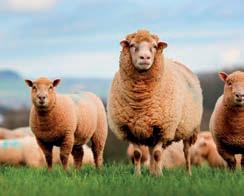


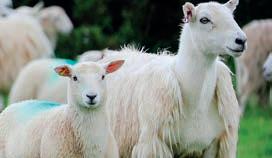













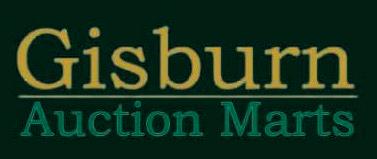

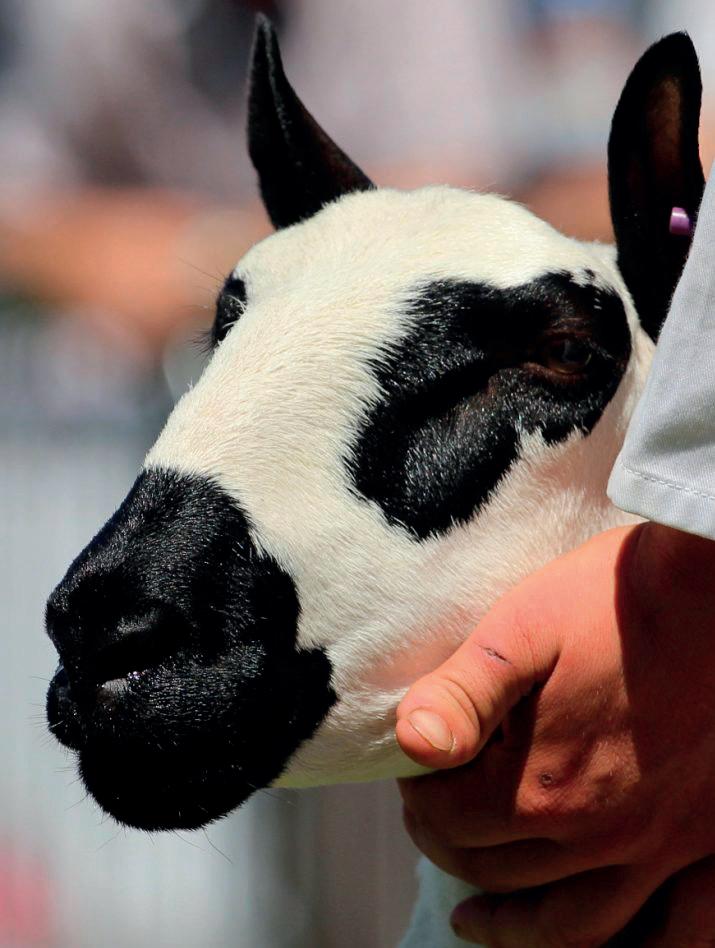

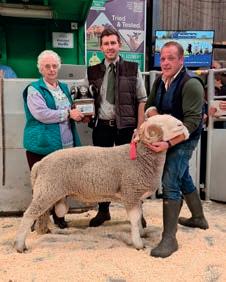
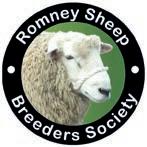



STORE LAMBS
Tuesday September 10th & Fortnightly 5000-8000 Lambs GIMMER LAMBS
Tues 10th Sept 2500 Suff x, Texel x & CTL x
Fri 13th Sept 2000 Masham,1250 Dales Mule & 2000 Chev Mule
Sat 14th Sept 12000 North of England Mules
Sat 28th Sept 5500 Mule & Cheviot Mule & 500 Masham BREEDING SHEEP
Fri 27th Sept 3000 Mule & Continental x Ewes & Shlgs
Tues 1st Oct 5000 Swaledale, Cheviot & Hill Ewes & Shlgs
Sat 19th Oct 4000 Breeding Ewes, Shlgs & Gimmer Lambs (Lowland & Hillbred Sheep- all breeds) RAMS
Fri 20th Sept 400 Terminal Sire Rams
Sat 21st Sept 400 BF Leicester & Teeswater (inc. Females)
Thurs 10th Oct 500 Swaledale, BFL & Other Crossing Breeds FARM TO FARM SALES- BREEDING/ STORE SHEEP
Available from N of England & Scottish Border Farms
For Catalogues and Sales List contact: S J Dennis of RICHARD TURNER & SON Main Street, Bentham, Lancaster LA2 7HF Tel: (015242) 61444 Mobile: 07713 075661 www.benthamauction.co.uk

Telephone: 01824 705000
MONDAY 2nd SEPTEMBER 2024
Sale @ 9.30am
23rd ANNUAL SALE OF – 736 LLEYN SHEEP
(680 Ewes & 56 Rams)
At the Vale of Clwyd Livestock Centre, Parc Glasdir, Ruthin, LL15 1PB *** *** *** *** ***
WEDNESDAY 4th SEPTEMBER 2024
Sale @ 11am prompt
69th ANNUAL SALE OF - 1,293 WELSH HALF BRED SHEEP (466 Yr Ewes & 827 Ewe Lambs)
For the Welsh Half Bred Breeders Association – Northern Region
At the Vale of Clwyd Livestock Centre, Parc Glasdir, Ruthin, LL15 1PB Held in conjunction with Jones Peckover *** *** *** *** ***
THURSDAY 5th SEPTEMBER 2024
SHOW & SALE OF - 55 BELTEX SHEEP
(22 Yearling Ewes, 16 Yearling Rams & 1 Ram Lamb) (Including 16 Non MV Yearling Rams) (On behalf of Clwb Beltex Cymru / Welsh Beltex Club)
At the Vale of Clwyd Livestock Centre, Parc Glasdir, Ruthin LL15 1PB Show @ 10am - Sale @ 12.30pm *** *** *** *** ***
Visit us @ www.ruthinfarmers.co.uk for much more weekly entries and the on line Catalogues of Sheep Breed Sales or contact the Auctioneers on 01824 705000 for a copy by post




Maternal Instinct Abundance of Quality Milk Up to 180% Production Several Crops of Lambs Easy Adaption to Lowland Pasture Good Feed Conversion
Join our buyers who return on 3-4 year cycle to benefit from ewes that are smaller in stature, easily handled with a lower grass consumption than larger breeds.Lamb beyond 5 years and maintain their price at cull. DRAFT EWE SALES 2024: Cockermouth (Mitchells) 4th October, 2024 Broughton (BCA) 7th October. Sept & Oct Sales at Penrith (P&DF), Kendal J36 (North West), Skipton (CCM) Contact Auction Companies for further details. www.herdwick-sheep.com secretary@herdwicks.org.uk
at SENNYBRIDGE MARKET, POWYS

Wed 25th Sept at 3pm - Annual Show & Sale of 1500 CHEVIOT BREEDING EWES & EWE LAMBS
Sat 28th Sept - Annual Show & Sale of 300 BRECKNOCK HILL CHEVIOT RAMS
Show at 9 am Sale at 10.30 am CLEE TOMPKINSON & FRANCIS Tel: 01874 622488
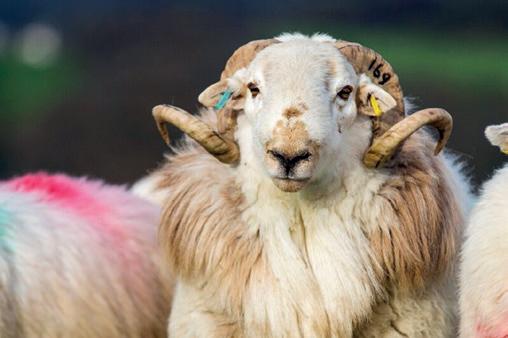
please view our website www.welshmountainsheep.cymru WELSH MOUNTAIN

Contact: Amanda Denver Telephone: 0788 997 6058 Email: rfsba@outlook.com www.roughfellsheep.com







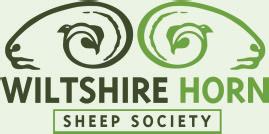



Wednesday 18th September
Annual Prize Show & Sale of Mule, Texel, Suffolk & Other Continental Gimmers
Thursday 19th September
Annual ‘Hexham’ Prize Show & Sale of Mule Ewe Lambs. Prize Show & Sale of Cheviot Mule Ewes Lambs. Also, on this day Second Sale of Hill & Other Lambs.
Monday 23rd September
Builth Wells Ram Sale
Wednesday 25th September
Annual Prize Show & Sale of Texel, Suffolk & Other Continental Shearlings & Ram Lambs. Also Bluefaced Leicester Show & Sale of Shearling Rams & Ram Lambs.
Thursday 26th September
‘Tow Law’ Prize Show & Sale of Mule Gimmer Lambs (Bluefaced Leicester x Swaledale)
Friday 27th September Show of Hill Bred Store Lambs.
Monday 30th September
Evening Show & Sale of Crossing Type Bluefaced Leicester Rams & Ram Lambs.
Thursday 3rd October
Sale of Mule, Cheviot, Swaledale & Other Ewes, Gimmers & Ewe Lambs Prize Show & Sale of Blackface & Swaledale Draft Ewes & Gimmers
Wednesday 9th October
Second Sale of Bluefaced Leicester, Texel, Suffolk & Other Continental Rams & Ram Lambs
Monday 14th October
Prize Show & Sale of Blackface Aged Rams, Shearlings & Ram Lambs
Thursday 17th October
Sale of Ewe Lambs of all breeds. Second Sale of Blackface & Swaledale Draft Ewes & Gimmers
Monday 28th October
Prize Show & Sale of Cheviot, Blackface & Swaledale Shearling Rams, Sale of Bluefaced Leicester, Texel, Suffolk & Other Continental Rams & Ram Lambs.
Phone: 01434 605444
Website: www.hexhammart.co.uk
Email: info@hexhammart.co.uk






























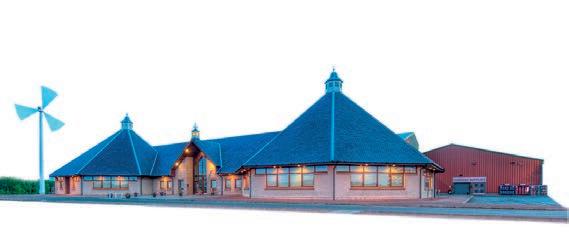
NORBROOK KELSO RAM SALES (within Border Union Showground) Comprising: 980 RAMS
Ring 3 - 45 MV-Acc Crosses
Ring 6 - 153 Charollais
Ring 7 - 214 Texels
Ring 9 - 250 Texels
Ring 15 - 226 Bluefaced Leicesters
Ring 16 - 42 Non-MV Acc Crosses
Ring 19 - 50 Unregistered Texels
SEPTEMBER PEDIGREE SHEEP SALE WEEK
SATURDAY 14TH SEPTEMBER
SHOW & SALE OF 59 VALAIS BLACKNOSE SHEEP
(On behalf of Scottish Valais Blacknose Club) Show: 12noon Sale: 2pm

WEDNESDAY 18TH SEPTEMBER
SHOW & SALE OF 147 BORDER LEICESTER SHEEP
(On behalf of Society of Border Leicester Sheep Breeders) Show: 9:30am Sale: In Ring 1 at 12:00pm
THURSDAY 19TH SEPTEMBER
SALE OF SUFFOLK SHEEP
Show: 9:30am Sale: In Ring 1 at 11:00am
Hampshire Down Pedigree Sheep
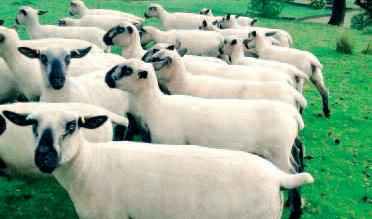

Tel: 07518
SAVERNAKE SUFFOLKS
40 Outdoor reared, grass fed, pedigree and commercial Suffolk shearling rams for sale
Vigorous modern type, with some New Zealand genetics, selected for low birth weight, high growth and muscling, and balanced terminal and maternal characteristics. MV accredited. Shearling ewes also available.




Immediately followed by
SHOW & SALE OF 235 TEXEL SHEEP
(On behalf of Scottish Texel Sheep Breeders Club)
Followed by: Reduction of the RUSHA flock (On behalf of Messrs J Gibb & Son)
Part Dispersal of the CARLINSIDE flock (On behalf of The Firm of Carlinside Farm) Show: 9:30am Sale: In Ring 1 at 11:00am
SHOW & SALE OF 251 BELTEX SHEEP
(On behalf of Beltex Scotland) (Arrival/Inspection/Judging – Wednesday 18th)
Part Dispersal of the COCHRANE’S flock (On behalf of Messrs J & JM Cochrane)
Inspection: 4pm-5pm Show: 5.30pm Sale:In Ring 2 at 10:30am

Immediately followed by
SHOW & SALE OF 40 DUTCH SPOTTED SHEEP
(On behalf of Dutch Spotted Sheep Society) Show: 9:00am Sale: In Ring 2 at approx 1.30pm



Miles Wise, North Yorkshire T: 07890 135183 | E: info@suffolkrams.co.uk
WORKING GENES
WORKING GENES
Bull & Ram Sale
60 texel and 60 lleyn shearlings
45 Texel, 45 Lleyn Shearlings
Bull & Ram Sale 45 Texel, 45 Lleyn Shearlings
Hardy active rams, grass fed only, Performance recorded 20 bulls (Sim, Luing, AA)
Hardy active rams, grass fed only, performance recorded 18 Bulls (Sim, Luing, AA) 38 Heifers (Sim x Luing)
Catalogue at www.incheochfarm.co.uk
Hardy active rams, grass fed only, performance recorded 18 Bulls (Sim, Luing, AA) 38 Heifers (Sim x Luing)
Catalogue at www.uagroup.co.uk
Catalogue at www.uagroup.co.uk
Neil McGowan 07788 100010
Neil McGowan 07788 100010 10th September
Neil McGowan 07788 100010
Online and on -farm Incheoch, Perth
On-farm Auction Incheoch, Perthshire Thurs 6th September
On-farm Auction Incheoch, Perthshire Thurs 6th September

Heifers 2pm, Bulls 3pm, Rams 6pm
Heifers 2pm, Bulls 3pm, Rams 6pm


Excellent conformation, tight skins, ready for work. Heptavac P. Naturally Reared, no corn
Contact Mr Brocklehurst on 07764 196462 or 01260 223338
BELTEX x TEXEL, BELTEX x CHAROLLAIS & CHARMOISE x BELTEX shearling rams.
Carefully bred for over 20 years, over 40 available, grass produced, no corn. The rams need to be seen. Heptavac P. No silly price.
Please contact Phillip Langton: 07815 123783 - Derbys
Lleyn - MV Signet Flock 1448
Enhancing profitability through Performance Recording.
Top 1-10% Index shearling tups, breeding for worm resistance and low-methane.
Grass-fed only. Registered and commercial. Culland Hall Farm, Derbyshire 07802 887814 www.culland-farm.co.uk


NO FIREARMS PERMIT REQUIRED SUITABLE FOR FARM ANIMALS OF ALL SIZES
Adler Captive Bolt Stunner just £215 + VAT


Adler Captive Bolt Stunner Package - Stunner, 100 Blanks, Carriage... just £249 + VAT
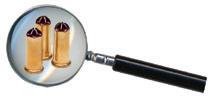
Please email your order to sales@raytradeuk.co.uk and we’ll contact you for payment. Further information on Humane Slaughter products can be found at www.raytradeuk.co.uk/humane-slaughter If you have any other questions or wish to make a payment over the telephone please call us on 01635 253344



Call 01772 799500 and place your advert today

We believe there is a simpler and fairer way to work together with wool farmers, and that’s why we are challenging the traditional UK wool sourcing systems.
WOOL TAKEN FROM ANYWHERE IN THE UK
MAIN DEPOTS:PERTH MUIRKIRK GALASHIELS WARMINSTER
Please phone to book your wool in to each depot.
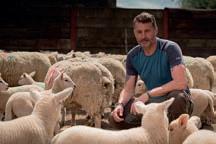
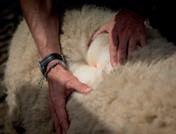



If you would like to supply Brannach Olann with your wool, please contact: Alan: 07836 547987 (Scotland) Steve: 07957 988181 (Wales)
Staffordshire, Derbyshire and surrounding area
Richard Toon
team has over 100 years experience working with British Wool, ensuring that your wool is expertly graded to industry standards guaranteeing a true market value.
Lower Ground Farm, Leek Road, Upper Mayfield, Ashbourne, Derbyshire DE6 2HR 01335 342 729 richard@dbwools.ie
North Derbyshire, Nottinghamshire, South Yorkshire and surrounding area
Staffordshire, Derbyshire and surrounding area
Rowbotham
Staffordshire, Derbyshire and surrounding area
Richard Toon
South Oaks Farm, Beeley, Matlock 2NR 07989 517456 petesheep@dbwools.ie
Richard Toon Lower Ground Farm, Leek Road, Upper Mayfield, Ashbourne, Derbyshire DE6 2HR 01335 342 729 richard@dbwools.ie
Lower Ground Farm, Leek Road, Upper Mayfield, Ashbourne, Derbyshire DE6 2HR 01335 342 729 richard@dbwools.ie
Cumbria & surrounding area
Pete Rowbotham South Oaks Farm, Beeley, Matlock DE4 2NR 07989 517456 petesheep@dbwools.ie
Corinna Cowin Appleby 07789 736428 corinna@dbwools.ie
Cumbria & surrounding area
Pete Rowbotham South Oaks Farm, Beeley, Matlock 2NR 07989 517456 petesheep@dbwools.ie
Corinna Cowin Appleby 07789 736428 corinna@dbwools.ie
Cumbria & surrounding area
Corinna Cowin Appleby 07789 736428 corinna@dbwools.ie
Richard Hopkinson Hilberry Farm Pisley, Chesterfield S45 8AJ 01246 850311 / 07813 896722 richardhopkinson@ dbwools.ie
North Derbyshire, Nottinghamshire, South Yorkshire and surrounding area
North Derbyshire, Nottinghamshire, South Yorkshire and surrounding area
Lancashire and surrounding area
Richard Hopkinson Hilberry Farm Pisley, Chesterfield S45 8AJ 01246 850311 / 07813 896722 richardhopkinson@ dbwools.ie
Mick Handley Clitheroe, Lancashire 07866 410 297 mick@dbwools.ie
Lancashire and surrounding area
Mick Handley Clitheroe, Lancashire 07866 410 297 mick@dbwools.ie
Richard Hopkinson Hilberry Farm Pisley, Chesterfield S45 8AJ 01246 850311 / 07813 896722 richardhopkinson@ dbwools.ie
David Preston Lancaster, Lancashire 07527 785 845 david@dbwools.ie
David Preston Lancaster, Lancashire 07527 785 845 david@dbwools.ie
Lancashire and surrounding area
Mick Handley Clitheroe, Lancashire 07866 410 297 mick@dbwools.ie

North Yorkshire and surrounding area
Becky Burniston South View Farm

Burnsall North Yorkshire BD23 6BX 07921 267904 becky@dbwools.ie
Yorkshire and surrounding area
Becky Burniston South View Farm Burnsall North Yorkshire BD23 6BX 07921 267904 becky@dbwools.ie
Mid-Wales
North Yorkshire and surrounding area
Gareth Thomas 07974 376995 gareth@dbwools.ie
Becky Burniston
Mid-Wales
South View Farm
North East Wales
Gareth Thomas 07974 376995 gareth@dbwools.ie
North East Wales
Burnsall North Yorkshire BD23 6BX 07921 267904 becky@dbwools.ie
Geraint Jones 07887 772804 Geraint@dbwools.ie
Geraint Jones 07887 772804 Geraint@dbwools.ie
Southern and Central Scotland

Mid-Wales
Southern and Central Scotland
Hugh Hamilton 07931 353961 hugh@dbwools.ie
Hugh Hamilton 07931 353961 hugh@dbwools.ie
Gareth Thomas 07974 376995 gareth@dbwools.ie
North East Wales
Geraint Jones 07887 772804 Geraint@dbwools.ie
Part of the Standard Wool group of companies
David Preston Lancaster, Lancashire 07527 785 845 david@dbwools.ie
Part of the Standard Wool group of companies
Southern and Central Scotland
Hugh Hamilton 07931 353961 hugh@dbwools.ie




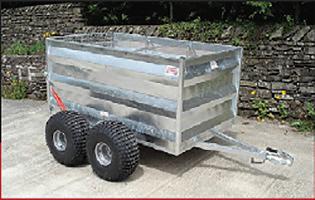
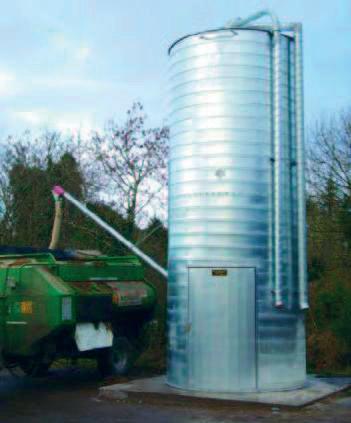

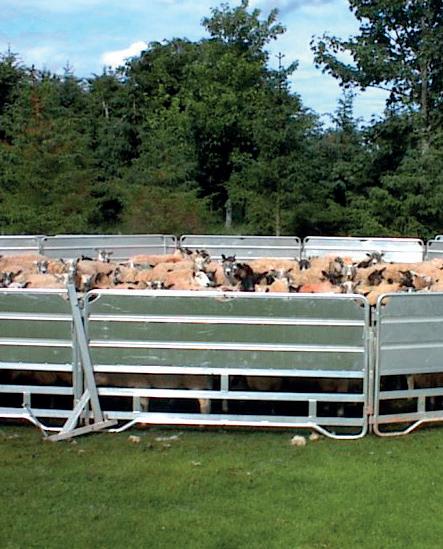





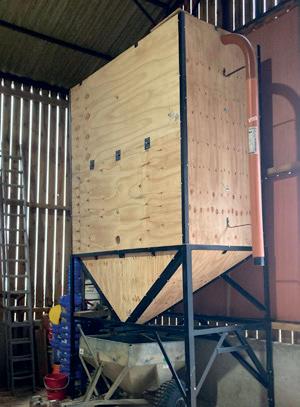



At Premier Polytunnels we know lambing season is the most important time of a sheep farmer’s year, not to mention the ewe’s, so it is no surprise that having quality lambing facilities is at the top of the farmer’s list.
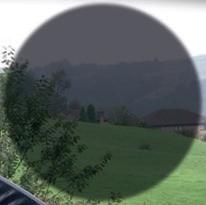




Key benefits of our sheep housing:
• More than 35 years of experience
• Improves animal welfare
• Reduces stress in the flock
• Pregnant ewes and housed sheep are cheaper to feed
• Supplied as a complete unit ready for assembly



• Sizes from 16ft to 30ft wide, and lengths from 30ft to 90ft
• 50mm and 60mm diameter steel hoops for strength and rigidity



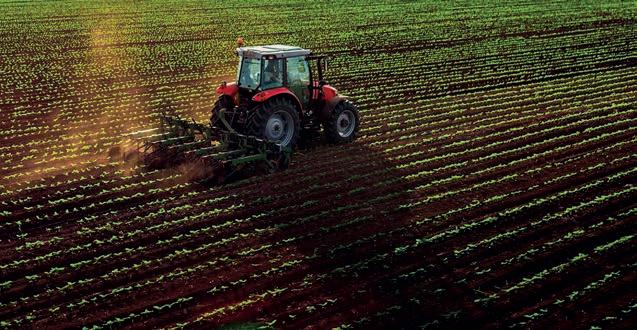



Raise
Competitive
Quick
CCJ’s
Older Equipment Considered
Quick Decisions Deal Sizes £20K Upwards
Competitive
CCJ’s, Current Trading Difficulties, All Considered Tenant Farmers Welcome England & Wales Only

